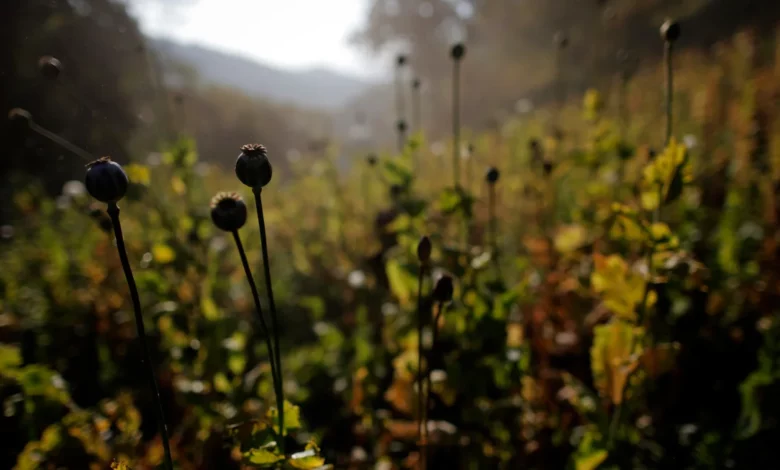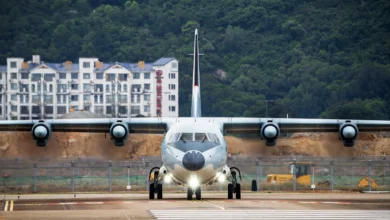
Myanmar has become the world’s biggest producer of opium, overtaking Afghanistan after the ruling Taliban imposed a ban on poppy cultivation, according to a new United Nations report.
The Southeast Asian nation produced an estimated 1,080 metric tons of opium in 2023, the highest since 2001, the UN Office on Drugs and Crime (UNODC) said in its report.
The Taliban’s strict ban on poppy cultivation, introduced last April in Afghanistan, slashed opium production in the country by 95 percent.
Given Afghanistan’s historically dominant role in illegal opium production, the UN said if the ban on the trade continues it could result in global shortages of opiates, including heroin — likely encouraging more production from Southeast Asia.
The Golden Triangle, a remote area where the borders of Thailand, Laos and Myanmar meet, has long been one of the world’s key narcotics hubs, notorious for its lawlessness and governed in some parts by local militias and warlords.
In 2023, the opium trade in Myanmar expanded for a third consecutive year, increasing 36 percent compared to 2022 production. The “entire opiate economy” in Myanmar is now worth between $1 billion and $2.5 billion, or between 2 percent and 4 percent of national GDP, according to the report.
For decades, Myanmar has been a major drug producing nation during decades of mostly military rule.
But much of the increased opium production has been further fueled by dire economic conditions and instability that have plagued the country since the military returned to power in a bloody 2021 coup, ending a brief experiment with democracy.
A deepening and deadly civil war has gripped the country, with fighting between junta troops and myriad armed resistance forces spreading to over two-thirds of the country, according to the UN.
Ballooning inflation, little access to markets and state infrastructure, and few other opportunities to make a living “appears to have played a significant role in farmers’ decisions in late 2022 to cultivate more poppy,” the report said.
“The economic, security and governance disruptions that followed the military takeover of February 2021 continue to drive farmers in remote areas towards opium to make a living,” said Jeremy Douglas, UNODC Regional Representative in a statement.
“The intensification of conflict in Shan and other border areas is expected to accelerate this trend,” he added, referring to one of Myanmar’s big drug-producing states that borders Laos, Thailand and China.
A more sophisticated operation
While poppy growing in Southeast Asia has generally been used as a cash crop, taking the form of traditional, small-scale plots, the UNODC found production in Myanmar “has become increasingly sophisticated and more productive.”
“Sowing poppy in densely organized plots” and the use of “irrigation systems, and sometimes fertilizers, have recently boosted plot yields and total production estimates to historic levels,” the report said.
The vast and hilly Shan state, in northwestern Myanmar, has long been the center of the country’s drug trade – with ideal conditions and climate for growing poppy and a dearth of law enforcement. According to the UNODC, opium production in Shan increased by 20 percent this year.
Ethnic armed organizations and militia groups control a patchwork of territory in the state, and have historically used narcotics and other illicit trades to finance their operations.
Since late October, fighting in Shan state has escalated as a trio of armed ethnic militias joined with resistance forces to mount a major new offensive against the junta.
Opium cultivation has also increased in Chin state to the east, Kachin state to the north, and in Sagaing, along Myanmar’s border with India, the UNODC said – areas that have seen increased fighting since the coup.
Synthetic drugs also surging
The expansion in opium poppy cultivation in Myanmar comes as the production of synthetic drugs, such as methamphetamines, has surged.
In recent years, powerful ethnic militias and major transnational organized crime syndicates have come together to produce and traffic synthetic drugs at an “unprecedented scale” in Shan state, according to UNODC’s Douglas.
Asia’s drugs cartels generate billions of dollars through the global narcotics trade while attracting a fraction of the attention of their counterparts in Latin America, in part because they keep a much lower profile and are less prone to bouts of internecine warfare.
Capitalizing on Myanmar’s political instability and conflict, these transnational crime and militia groups have built a billion-dollar industry through drug production and trafficking, money laundering, illegal casinos and online scam operations.
Other UNODC findings in recent years have painted a picture of a booming drug industry in Asia, with crime groups establishing new trafficking routes to evade enforcement crackdowns and methamphetamine prices hitting fresh lows.
Recent seizures of record amounts of methamphetamine in neighboring Laos suggest the country has been increasingly targeted as a transit point, the UNODC report said.
Trafficking through the province of Bokeo has been increasingly tied to markets in Australia, Japan, New Zealand, South Korea and other countries in Southeast Asia, it found.
“The crime and governance challenges in the region are compounded by the crisis in Myanmar. Southeast Asia needs to come together to find solutions to both traditional and emerging threats,” Douglas said.




